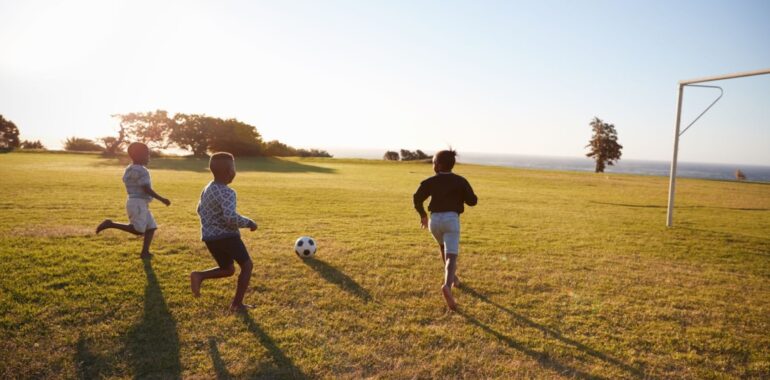by Kasey Woo, Fundraising and Grant Writing Intern at The Buddy Fund.
Keeping low-income kids in the game
As the cost of playing sports rises, sports are becoming ‘pay to play’, where the middle class and wealthy play, while the less fortunate miss out on this life-changing opportunity. A combination of financial concerns, lack of adequate playing spaces, the prevalence of food deserts, and much more, block many underprivileged kids from reaching the playing field. In addition, a lack of cheap and reliable transportation exacerbates the inequalities further. These issues have gone on for too long and will not get resolved overnight. However, by addressing them and taking consistent action, we can finally close the gap.
Money- A Major Barrier to Entry:
In a research report by RAND Corporation, a survey sample of 2048 parents showed that 66% of middle and higher-income youths (household income greater than or equal to $50k) participated in organized sports, while only 52% of lower-income kids (household income < $50k) did so. Looking at barriers to youth sports entry, it is not hard to see why. In this same report, the two most cited barriers were cost and time commitment. Among the middle and higher-income families, the biggest barrier to potentially interested youth was time commitment (45%), followed by the cost (26%). For families from poor backgrounds, the reverse was true, where 42% cited price as the main barrier, while 24% cited the time commitment. During the ‘pay to play’ era, the rising costs coupled with the recent athletic budget cuts due to COVID further fuel the flame. Looking at the chart below, travel costs make up the biggest portion of the total cost of sports. Besides the explicit travel cost of $196, more demeaning are the implicit costs of traveling. Being able to conveniently travel requires having a vehicle, which many poor families cannot afford. On top of that, there are other costs to owning a vehicle, such as insurance, maintenance, and gas expenses. An alternative to using a car would be public transportation, but the reduced cost is counterbalanced by low reliability and longer commute times.
One of the best ways to solve the transportation situation is by voting for public transit initiatives. In fact, in 2020, due of the power of voters, the U.S. was able to pass 15 out of 18 such measures. These measures represent over $38 billion in funding, and include investments in bus and rail systems, as well as anti-displacement measures. Such investments will allow public transportation to reach more places and improve efficiency. Voting for such measures in the future will keep the ball rolling. Besides the public transportation system, another promising solution is to donate funds or even a used car to a car nonprofit such as Vehicles For Change. This is a guaranteed way to increase sports participation, since 100% of the Vehicles For Change recipients reported taking their children to sports and after-school activities after receiving a subsidized car.
Besides wealth dictating how many kids play sports, household income also dictates what types of sports children play. The 2 charts from the Aspen Institute (above and below respectively) highlight this phenomenon.
The average cost for a child to play lacrosse is $1289, which is on the higher end of average annual spending. It is no surprise, therefore, that 7 out of 10 lacrosse players come from a family making an income of at least $75k. The participation for a swimming team shows a similar trend, with an average annual cost of $786 with 64% coming from a household making at least $75k annually. Furthermore, these prices do not take into account the implicit costs, which further discourage sports participation. For some kids to afford playing sports, it would require the necessary funds, which is hard for a family that is scraping by. Families will not worry about enrolling their kids in sports when their focus is simply putting food on the table. Older kids have the option of getting a part-time job to fund their activities, but this only represents a portion of all youth, and scheduling conflicts between work and sports may prevent them from using the money for its intended purpose.
In addition, the lack of athletic opportunities make these kids more susceptible to the pitfalls of a sedentary lifestyle, such as heart-disease and type II diabetes. Treating health conditions is costly and would further devastate those struggling financially. If given the chance to play, these kids can stay in shape and save money on such health-related fees. Aditionally, athletes have to worry about sports-related injuries, which can easily rack up medical bills in the thousands.
To close the opportunity gap between high and low-income youth, the government could allocate more funds to public schools. Doing this would prevent schools from having to charge the ‘pay to play’ fee that is used to avoid budget cuts. Furthermore, donating to charitable sports organizations, such as The Buddy Fund, will provide the funds necessary for creating an economically diverse playing field.
Lack of Safety and Playing Spaces:
To foster physical activity, people need access to safe playing places such as parks. Additionally being closeby to one is a huge plus. A study of 3161 people aged 5-20 analyzed walking habits based on the participants’ proximity to outdoor recreational spaces such as parks. Those living near recreational spaces were more likely to walk, with those aged 12-15 getting the largest effect. In fact, the odds were 2.5 times greater for them if they reported a recreational destination within 1 km from home! Marginalzed communities, often lacking nearby parks, are not able to create this fostering environment for exercise.
Even if marginalized residents live near a park, they have to worry about the quality as well. A study of 28 park features from 33 parks brings this to light. Participants from each park kept a 7-day log of their exercise habits. Across the board, parks with good features, such as playgrounds and trails, were more likely to be used for physical activity. The most important of these features is having a paved trail, which increases the likelihood of using a park by almost 26 times! The problem is that these low-income communities lack the necessary funding to have such features in their parks. Even if they have such features, they are not maintained regularly.
Besides lacking high-quality playing spaces, safety is also a concern. Poorly maintained neighborhoods lack sidewalks, making it unsafe for many kids to play right outside their homes. Because parks are usually farther away, it is difficult for parents to supervise their kids, especially due to the transportation problems mentioned earlier. These areas, characterized by high crime, pose a risk to the youth, and playing outside makes them the perfect target for criminals to prey on, especially in the absence of adult supervision. Besides that, poorly maintained parks could pose safety risks. For instance, a bench with chipped wood is likely to give people splinters.
Addressing these issues, initiatives toward park construction/renovation should be voiced, with an emphasis on adding park features that encourage the most participation. With good quality parks near the house, parents won’t have to fret over the safety of their children and are more likely to let them play outside.
Food Deserts:
Besides training, a solid nutrition plan is key for staying in the game. The muscles are broken down during training, and a solid nutrition plan will enable athletes to recover faster, feel better, and avoid injuries. Besides the lack of athletic opportunities, low-income communities are often characterized as food deserts, which are areas with low access to affordable and healthy food options. When there is a fast-food joint or gas station around the corner, no wonder people find grocery shopping inconvenient. Due to a lack of reliable transportation, getting to the store is hard for those in marginalized areas. Even if they go out of their way to grocery shop, they must spend their budget on foods that will fill them up for the cheapest price: many of which are unhealthy. In fact, a meta-analysis of 27 studies across 10 countries showed that it costs about $1.50 more per day per person to eat healthy. Adding this to a shoestring budget could have disastrous financial consequences. For low-income kids, many see athletic scholarships as a pathway to better opportunities. However, without the ability to recover properly, how will these kids even achieve this dream?
Luckily, there is hope, and there are many ways to convert a food desert into a food oasis. One solution is to donate to food insecurity organizations, such as Feeding America and No Kid Hungry. Secondly, growing produce locally, especially through a community garden, would reduce long trips to the store, and encourage an environment of healthy eating. There could be all the healthy food in the world, but without health education, these people will never consider eating healthy. People are largely influenced by their environment, so creating one with healthy habits will not only help the athletes, but those around them as well!
Final Thoughts:
Consistent physical activity and proper eating habits are critical for living a good life, but barriers such as money, access to playing spaces, and food deserts, put low-income kids at a disadvantage. Adding to this flame is the lack of cheap dependable transportation. However, by attacking these issues with the proposed solutions, we can break down the barriers once and for all.
Sources:
Frank L, Kerr J, Chapman J, Sallis J. Urban form relationships with walk trip frequency and distance among youth. Am J Health Promot. 2007 Mar-Apr;21(4 Suppl):305-11.
Kaczynski, Andrew T et al. “Association of park size, distance, and features with physical activity in neighborhood parks.” American journal of public health vol. 98,8 (2008): 1451-6. doi:10.2105/AJPH.2007.129064
Knop, Brian. “Even Short-Term Spells of Poverty Lower School-Aged Children’s Involvement in Extracurricular Activities.” The United States Census Bureau, The United States Census Bureau, 23 Sept. 2020, www.census.gov/library/stories/2020/09/children-in-poverty-less-likely-to-participate-in-sports-gifted-programs.html.
“Parks & Recreation in Underserved Areas: A Public Health Perspective.” Nrpa.org, National Recreation and Parks Association, www.nrpa.org/uploadedFiles/nrpa.org/Publications_and_Research/Research/Papers/Parks-Rec-Underserved-Areas.pdf.
Picchi, Aimee. “Game over: Middle-Class and Poor Kids Are Ditching Youth Sports.” CBS News, CBS Interactive, 15 Aug. 2019, www.cbsnews.com/news/uneven-playing-field-middle-class-and-poor-kids-are-ditching-youth-sports/.
Ploeg, Michele Ver, et al. “Mapping Food Deserts in the United States.” USDA Economic Research Service, U.S. Department of Agriculture, 1 Dec. 2011, www.ers.usda.gov/amber-waves/2011/december/data-feature-mapping-food-deserts-in-the-us/.
Rao, Mayuree et al. “Do healthier foods and diet patterns cost more than less healthy options? A systematic review and meta-analysis.” BMJ open vol. 3,12 e004277. 5 Dec. 2013, doi:10.1136/bmjopen-2013-004277
“Voters Across the Country Support Public Transportation in Record Numbers.” American Public Transportation Association, American Public Transportation Association, 16 Nov. 2020, www.apta.com/news-publications/press-releases/releases/voters-across-the-country-support-public-transportation-in-record-numbers/.
Whitaker, Anamarie A., Garrett Baker, Luke J. Matthews, Jennifer Sloan McCombs, and Mark Barrett, Who Plays, Who Pays? Funding for and Access to Youth Sports. Santa Monica, CA: RAND Corporation, 2019. https://www.rand.org/pubs/research_reports/RR2581.html.
“Youth Sports Facts: Challenges To Physical Activity.” The Aspen Institute Project Play, Project Play, www.aspenprojectplay.org/youth-sports-facts/challenges.



